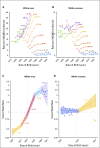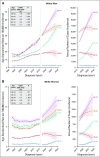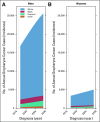Evolution of the Oropharynx Cancer Epidemic in the United States: Moderation of Increasing Incidence in Younger Individuals and Shift in the Burden to Older Individuals
- PMID: 31026209
- PMCID: PMC6599405
- DOI: 10.1200/JCO.19.00370
Evolution of the Oropharynx Cancer Epidemic in the United States: Moderation of Increasing Incidence in Younger Individuals and Shift in the Burden to Older Individuals
Abstract
Purpose: Human papillomavirus-positive oropharynx cancer incidence has increased rapidly in cohorts of US white men born during the 1930s to 1950s. It is unknown how the trajectory of the oropharynx cancer epidemic may be changing in the United States.
Methods: Using US cancer registry information, we investigated whether increases in oropharynx cancer have continued into recent birth cohorts and forecasted the future burden across age, sex, and race/ethnicity subgroups. Log-linear Joinpoint regression and age-period-cohort models were used to evaluate incidence trends during 1992 to 2015 and projections through 2029.
Results: Among white men, oropharynx cancer incidence increased rapidly in individuals born during 1939 to 1955 (5.3% per 2-year birth cohort; 95% CI, 4.8% to 5.7%), but this rate of increase significantly moderated in individuals born during 1955 to 1969 (1.7% per 2-year birth cohort; 95% CI, 1.0% to 2.4%). Should these birth-cohort trends continue, from 2016 to 2029 we forecast that incidence will increase dramatically in older white men 65 to 74 years of age (from 40.7 to 71.2 per 100,000) and 75 to 84 years of age (from 25.7 to 50.1 per 100,000), moderately in white men 55 to 64 years of age (from 40.3 to 52.0 per 100,000), and remain stable in white men 45 to 54 years of age (approximately 18 per 100,000). Accounting for population growth, we project an increase in annual number of cases in the United States from 20,124 (95% CI, 19,779 to 20,469) in 2016 to 30,629 (95% CI, 29,413 to 31,845) in 2029, primarily driven by older individuals (age ≥ 65 years; from 7,976 [95% CI, 7,782 to 8,172] to 18,072 [95% CI, 17,271 to 18,895]) and white men (from 14,453 [95% CI, 14,142 to 14,764] to 22,241 [95% CI, 21,119 to 23,364]).
Conclusion: The exponential increase in oropharynx cancer incidence in young white US men has ebbed, and modest increases are occurring/anticipated in cohorts born after 1955. Continued strong increases in incidence in cohorts born before 1955, and an approximate 50% increase in size of the US population age 65 years or older through 2029, portend a substantial shift in burden to elderly white men.
Figures




References
-
- Frisch M, Hjalgrim H, Jaeger AB, et al. Changing patterns of tonsillar squamous cell carcinoma in the United States. Cancer Causes Control. 2000;11:489–495. - PubMed
-
- Sturgis EM, Cinciripini PM. Trends in head and neck cancer incidence in relation to smoking prevalence: An emerging epidemic of human papillomavirus-associated cancers? Cancer. 2007;110:1429–1435. - PubMed
-
- Chaturvedi AK, Engels EA, Anderson WF, et al. Incidence trends for human papillomavirus-related and -unrelated oral squamous cell carcinomas in the United States. J Clin Oncol. 2008;26:612–619. - PubMed
Publication types
MeSH terms
Grants and funding
LinkOut - more resources
Full Text Sources

